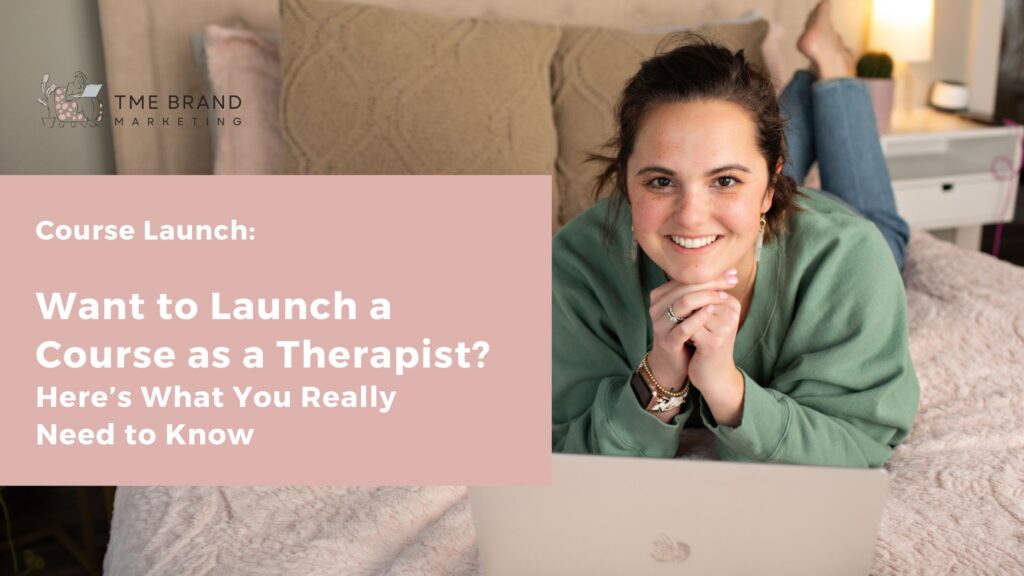
Want to Launch a Course as a Therapist?
Here’s What You Really Need to Know
Because you can only raise your rates so many times—and your kids keep asking for snacks like they’re on payroll.
You’ve spent years building your expertise as a therapist. You’ve got systems, frameworks, and insights that help your clients create real change—and maybe, just maybe, you’ve thought: “I could turn this into something more.”
Spoiler alert: You can.
And if you’re looking to expand your income, grow your reach beyond your state licensure, and help more people on your terms, creating a course might be your next smartest move.
But let’s be real: launching a course is more than filming a few videos and crossing your fingers. It’s a process—one that needs a plan, a platform, and a whole lot of emails (yes, more than the number of shoes in your minivan).
Here’s what most therapists don’t realize when they step into the course world—and the launch tips you need to get it right from the start.
Book Your Free 15-minute Course Consult Today!
Thinking about launching a course but not sure where to start? Let’s chat. Book your free course consult and we’ll help you figure out what’s possible, what to prioritize, and how to turn your expertise into a course that actually sells (without the tech meltdown). No pressure, no jargon—just a clear next step.
1. A Course Can Work With Your Practice, Not Compete With It
Courses are a great way to offer support beyond your licensure boundaries—especially if you market them as separate from your clinical services. Think: educational tools, coaching programs, or self-guided resources that provide your signature support without stepping into therapy territory.
It’s also a powerful way to diversify your income. With the right launch strategy and a strong niche, your course can bring in consistent, recurring revenue—without needing to see more clients or work longer hours. (Or negotiate childcare during every school holiday that somehow wasn’t on your calendar.)
2. You Need a Plan to Build Your Email List
We love Instagram, but when it comes to selling a course, email is king. If you don’t already have an email list, that’s priority number one.
Start by creating a freebie funnel—a short guide, quiz, or checklist that speaks directly to your niche and gets people to sign up for your list. Think: “5 Questions to Ask Before Choosing a Couples Therapist” or “The Sunday Night Anxiety Reset.”
Your freebie should lead to valuable, aligned content that builds trust and positions your course as the natural next step.
Bonus tip: Make it easy to digest. Because no one—therapist or not—wants to download a 40-page PDF when they’re already balancing 16 tabs and a toddler yelling “MOM!” from the bathroom.
3. Choose an All-in-One Platform (Save Your Sanity)
Can you piece together a course with Google Drive, PayPal, and DMs? Sure. Should you? Not unless you enjoy chaos, broken links, and middle-of-the-night login resets.
Instead, use an all-in-one course platform that handles:
Hosting your content
Checkout and registration
Email automation
Affiliate tracking (if you want it)
Platforms like Kajabi, Podia, or Thinkific are therapist-approved for being user-friendly and easy enough to figure out between kid drop-off and coffee number two.
4. Not Every Course Needs a Facebook Group
A community space can be wonderful… or just one more thing to moderate while making dinner.
Don’t feel pressured to include a Facebook group just because “everyone else is doing it.” If your audience thrives in solo learning or you don’t have the time to manage a group, it’s totally okay to skip it.
Focus instead on delivering solid, self-contained content and creating connection through live sessions or email check-ins.
5. Urgency Sells—Create a Launch Window
Want people to buy your course? They need a reason to buy now (just like your 4-year-old needed a granola bar immediately or he’d “literally starve”).
A typical launch includes:
A cart open and cart close date (usually 5–7 days)
Early bird pricing or a “founding cohort” discount
A can’t-say-no offer like a bonus 1:1 call or discounted rate
Here’s the truth: discounts drive sales more than bonuses. Everyone loves a deal. Give them a deadline and a reason to take action, and you’ll see more conversions.
6. Yes, You Need to Send a LOT of Emails
Here’s where most therapists panic.
“But won’t people unsubscribe if I send that many emails?!”
Here’s the truth: email is the foundation of a successful course launch. In our launches, we usually send:
2–3 warm-up emails before enrollment opens
9–11 emails during the 7-day enrollment period
Yes, that’s 12–14 emails total. And nope, that’s not “too much.” It’s just the visibility your offer needs to get the results you want.
Still nervous? Add an opt-out link for just the sales emails—so your list can stay warm, not annoyed.
7. A Lot Happens Before You Even Build the Course
You don’t need to have the whole course filmed and edited to launch it. In fact, that’s one of the biggest mistakes people make.
Here’s how we recommend doing it:
Build your sales page and checkout process
Launch with a strong email and content strategy
Get your first enrollments
THEN build and deliver your modules to real, excited students
It’s like meal prepping: don’t cook the whole buffet until you know how many people are coming over.
The Bottom Line: You Don’t Have to DIY This
You’re a therapist, not a tech wizard with 14 arms and a full-time marketing degree. But we are.
If you’re ready to turn your expertise into a course that makes money while you’re in session—or gasp on vacation—we’re here to help.
We’ll handle the tech, the strategy, the design, the emails, and even the webinar setup (yes, all of it).
👉 Ready to launch your course with confidence and keep your cool? Book a free consult below.
SCHEDULE A CALL
Free Discovery Call
This call is an opportunity to understand where you are right now and explore how the TME Brand Marketing Team can help you reach your goals. Find a time on our calendar to schedule your call today—we’re excited to connect with you soon!




